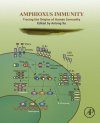![Amphioxus Immunity Amphioxus Immunity]()
Click to have a closer look
About this book
Contents
Customer reviews
Biography
Related titles
About this book
Amphioxus Immunity: Tracing the Origin of Human Immunity covers a remarkable range of information about Amphioxus and its evolutionary context. This compilation of what is currently known about Amphioxus, with a sharp focus on its immune system, includes 13 topics, such as:
- Amphioxus as a model for understanding the evolution of vertebrates
- basic knowledge of immunology
- immune organs and cells of amphioxus
- a genomic and transcriptomic view of the Amphioxus immunity
- pattern recognition system in Amphioxus
- transcription factors in Amphioxus
- the complement system of Amphioxus
- the oxidative burst system in Amphioxus
- immune effectors in Amphioxus
- lipid signaling of immune response in Amphioxus
- apoptosis in amphioxus; primitive adaptive immune system of Amphioxus
- and future research directions
This valuable reference book is loaded with information that will be useful for anyone who wishes to learn more about the origin of vertebrates and adaptive immunity.
Contents
Dedication
List of Contributors
About the Author
Foreword
Preface
Chapter 1: Amphioxus as a Model for Understanding the Evolution of Vertebrates
Abstract
1.1. Brief introduction of amphioxus
1.2. Biology of amphioxus
1.3. The story of amphioxus and early research studies in China
Chapter 2: Basic Knowledge of Immunology
Abstract
2.1. Immune organs
2.2. Immune cells
2.3. Innate immunity
2.4. Adaptive immunity
2.5. Complement system
Chapter 3: Immune Organs and Cells of Amphioxus
Abstract
3.1. Introduction
3.2. Organs of the amphioxus immune system
3.3. Cells of the amphioxus immune system
Chapter 4: Genomic and Transcriptomic View of Amphioxus Immunity
Abstract
4.1. Introduction
4.2. Trace evidence of adaptive immunity
4.3. Extraordinary gene expansion in amphioxus innate immunity
4.4. Regulation of the amphioxus immune system
4.5. Discussion
Chapter 5: Pattern Recognition System in Amphioxus
Abstract
5.1. TLR signaling pathway in amphioxus
5.2. Innate antiviral immunity in amphioxus
5.3. NLR signaling pathway
Chapter 6: Transcription Factors in Amphioxus
Abstract
6.1. NF-?B family members in amphioxus
6.2. The interferon regulatory factor family in amphioxus
6.3. The STATs in amphioxus
Chapter 7: The Complement System of Amphioxus
Abstract
7.1. Introduction
7.2. Tracing the evolutionary origin of the complement system
7.3. The complement system of amphioxus
Chapter 8: The Oxidative Burst System in Amphioxus
Abstract
8.1. Introduction
8.2. NADPH oxidase 2 and the other NOX families
8.3. NOX subunits and regulatory proteins
8.4. Functions of ROS generated by NADPH oxidases
8.5. Phagocytic respiratory burst (PRB) appears to couple with phagocytosis in the amphioxus gut epithelial lining cells
Chapter 9: Immune Effectors in Amphioxus
Abstract
9.1. Galectin
9.2. C-type lectin
9.3. Peptidoglycan recognition protein
9.4. Gram-negative bacteria-binding protein
9.5. Chitin-binding protein
9.6. Apextrin-like protein
9.7. Bactericidal/permeability-increasing protein
9.8. Other effector genes
Chapter 10: Evolution of Inflammation-Related Lipid Metabolism Pathway and Inflammatory Lipid Signaling in Amphioxus
Abstract
10.1. Introduction
10.2. The classification, structure, and function of fatty acids and eicosanoids
10.3. Origin of vertebrate eicosanoid production
Chapter 11: Apoptosis in Amphioxus
Abstract
11.1. Apoptosis in mammals
11.2. Apoptosis-related gene families in amphioxus
Chapter 12: Primitive Adaptive Immune System of Amphioxus
Abstract
12.1. Evidence of the emergence of adaptive immunity in amphioxus
12.2. The primary building blocks for MHC and Rag protein
12.3. Alternative forms of variable immune receptors
12.4. Closing remark
Chapter 13: Future Research Directions
Abstract
13.1. Ubiquitination of immune signaling in amphioxus
13.2. The microRNAs in amphioxus
13.3. Alternative 3’ UTRs in the amphioxus immune response
Abbreviation Index
Subject Index
Customer Reviews
Biography
An-Long Xu was awarded a government scholarship to study in the United States after his B.S. degree from Sun Yat-sen University in 1985. He went to the University of Illinois at Urbana-Champaign (UIUC) in Sep 1986 to pursue his graduate study in immunogenetics under Dr. Harris Lewin's supervision and obtained his Ph.D. from UIUC in 1992. Dr. Xu then did his postdoctoral research in Dr. Helen M. Ranney's lab at the University of California, San Diego for 2 years. Dr. Xu joined a San Diego-based Alliance Pharmaceutical Corp from 1994-1996 and worked on new drug discovery. After 10 years of study and research work in the U.S., he joined the faculty of Department of Biochemistry at College of Life Sciences, Sun Yat-sen University, his alma mater, in 1996. Dr. Xu currently is a professor in molecular biology and immunology, Director of National Engineering Center for Marine Biotechnology of South China Sea. Dr. Xu was appointed to Vice-President for research and development of Sun Yat-sen University in 2008 after serving as Dean of the College of Life Sciences for 9 years. He was promoted as President of Beijing University of Chinese Medicine in 2013. Dr. Xu has published more than 100 papers in peer-reviewed international journals, such as N. Engl J Med, Sci Signal, Genome Res, Am J Hum Genet, and J Immunol. Dr. Xu is currently President of Guangdong Society of Biochemistry and Molecular Biology and Vice-President of International Society for Developmental and Comparative Immunology. He currently serves on the Editorial Board for the following international journals: Annual Review of Animal Bioscience, BMC Genomics, and Animal Biotechnology. At the end of last century, Dr. Xu started his study on the origin and evolution of human immunity using Amphioxus as a model organism. His lab is now one of the pioneer labs in the world to study amphioxus immunity, although this species had been an iconic model for the evolutionary biology for more than 200 years. Instead of using conventional immunological methods only, his lab combined traditional immune methods with cellular, biochemical and molecular approaches, particularly genomic approach, to conduct a comprehensive survey on the immune response of amphioxus to bacterial infection, which gave us a quick open-up for this brand new field. For last 15 years, his lab has contributed more than 40 papers related to amphioxus immunity, which made a great contribution to the knowledge of amphioxus immunity and the understanding of origin and evolution of vertebrate's immunity, especially human immunity.



































